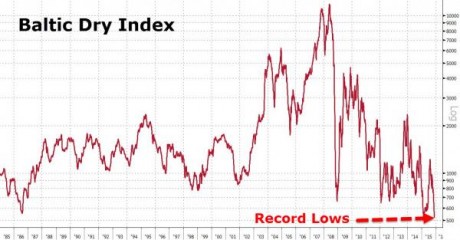Oil May Plunge to $20, Signalling Economic Depression
Nov. 22, 2015
The price of oil has long been a key indicator of economic health and stability. And that index is tanking fast. In the last few years, dramatic overproduction of oil has become a major tool of geopolitical conflict. When oil was over $100/barrel here was so much money in it that oil companies were expanding as fast as they could. Even the new technology of “fracking” (it produces more oil but costs more to produce) became popular. Deeper wells were being drilled, tapping more and larger oil deposits. So money was piling up for the 1% folks.
But other dynamics were at work … public debt, like college loans and the subprime mortgage bubble, were undermining the economy of the average American. The top 1% were rolling in dough, but American families were hitting bottom … which led to the loss of confidence and a huge downturn in new purchases and applications for loans for homes and other things financed by banks. People were simply afraid of more debt.
For several years now America has been plunging into economic depression (news media usually refers to this as “deflation,” or “economic slowdown,” or “recession.” Whatever euphemistic term they choose, it equates to DEPRESSION because it means that cash is being extinguished faster than it is being created. All this while the so-called economists have, for the last decade, been warning us of “hyperinflation” … just the opposite of what has occurred. The US dollar index has now bouncing near 100% (I think it is at 99.6 today). Last May it was below 70%. The dollar index rises as the money supply drops … and a dropping money supply equals DEPRESSION.
Oil prices have plummeted from $110/barrel to $40, Americans have tapped huge sources of fracking and flooded the market; OPEC and the Saudis have continued pumping despite dropping prices; Russia, dependent upon oil for its economy, has been under siege via sanctions and bottom-level prices; ISIS and other terror organizations are undercutting everyone with illegal oil sales and China remains large in the whole affair.
Proxy wars and threats and rumors of world war have accompanied bitter economic warfare over currencies and energy. Now, oil is at a record level of glut, and nearly every storage facility in the world is filled past capacity.
The London Telegraph reports:
The world is running out of storage facilities for surging supplies of oil and may soon exhaust tanker space offshore, raising the chances of a violent plunge in crude prices over coming weeks, experts have warned.
Goldman Sachs told clients that the increasing glut of oil on the global market […] could send prices plummeting to $20 a barrel, the so-called ‘cash cost’ that forces drillers to abandon production. “Risks of a sharp leg lower remain elevated,” it said.
[…]
It is estimated that at least 100m barrels are now being stored on tankers offshore, waiting for better prices. A queue of 39 vessels carrying 28m barrels is laid up outside the Texas port of Galveston, while the Iranians have a further 30m barrels offshore ready to sell as soon as sanctions are lifted.
“The world is floating in oil, and commercial stocks on land are at a record high,” said David Hufton, head of oil brokers PVM Group. “The numbers we are facing now are dreadful. Stocks have been building continuously for two years. This is unprecedented.”
Already $40 barrels of oil has put major stresses on the world, and right now tankers filled will oil are lined up off the coast of Galveston, Texas, and will be waiting there indefinitely for many months. It is enough to drive oil and fracking firms out of business, and is currently resulting in a flood of layoffs – contributing to further joblessness and economic downturn, or perhaps outright disaster.
Hold on tight, things may be getting rocky indeed. Until then, enjoy the easy pump prices.
————————————————————————–
The Baltic Dry Shipping Index Just Collapsed To An All-Time Record Low
The Baltic Dry Shipping Index has plummeted to a new all-time record low of 504 at one point on Thursday. Everyone is hearing about the dramatic slowdown in global trade, but things have gotten bad quickly. Not even during the darkest moments of the last financial crisis did the Baltic Dry Shipping Index drop this low. Something doesn’t seem to be adding up, because the mainstream media keeps telling us that the global economy is doing just fine. In fact, the Federal Reserve is so confident in our “economic recovery” that they are getting ready to raise interest rates. Of course the truth is that there is no “economic recovery” on the horizon. In fact, there are signs all around us that are indicating that we are heading directly into another major economic crisis. This staggering decline of the Baltic Dry Shipping Index is just another confirmation of what is directly ahead of us.
Overall, the Baltic Dry Index is down more than 60 percent over the past 12 months. Global demand for shipping is absolutely collapsing, and yet very few “experts” seem alarmed by this. If you are not familiar with the Baltic Dry Shipping Index, the following is a pretty good definition from Investopedia…
A shipping and trade index created by the London-based Baltic Exchange that measures changes in the cost to transport raw materials such as metals, grains and fossil fuels by sea. The Baltic Exchange directly contacts shipping brokers to assess price levels for a given route, product to transport and time to delivery (speed).
The Baltic Dry Index is a composite of three sub-indexes that measure different sizes of dry bulk carriers (merchant ships) – Capesize, Supramax and Panamax. Multiple geographic routes are evaluated for each index to give depth to the index’s composite measurement.
It is also known as the “Dry Bulk Index”.
Much of the decline of the Baltic Dry Shipping Index is being blamed on China. The following comes from a Bloomberg report that was posted on Thursday…
The cost of shipping commodities fell to a record, amid signs that Chinese demand growth for iron ore and coal is slowing, hurting the industry’s biggest source of cargoes.
The Baltic Dry Index, a measure of shipping rates for everything from coal to ore to grains, fell to 504 points on Thursday, the lowest data from the London-based Baltic Exchange going back to 1985. Among the causes of shipowners’ pain is slowing economic growth in China, which is translating into weakening demand for imported iron ore that’s used to make the steel.
So many of the exact same patterns that we witnessed back in 2008 are playing out once again in front of our very eyes. Below, I have shared a chart that was posted by Zero Hedge, and it shows how the Baltic Dry Shipping Index absolutely collapsed in 2008 as we headed into a major financial crisis. Well, now the Index is collapsing again, and it is already lower than it was at any point back in 2008…
 The evidence continues to mount that we are steamrolling toward a deflationary economic slowdown that is worldwide in scope. (Remember, “deflation” equates to “depression.” In a depression, cash is king. Now is not the time to borrow or invest. Save your cash! It is you best investment in depression.)
The evidence continues to mount that we are steamrolling toward a deflationary economic slowdown that is worldwide in scope. (Remember, “deflation” equates to “depression.” In a depression, cash is king. Now is not the time to borrow or invest. Save your cash! It is you best investment in depression.)
Just look at the price of U.S. oil. It just keeps on falling, and as I write this article it is sitting at $40.40.
The price of oil collapsed just before the financial crisis of 2008, and the same pattern is happening again.
And look at what is happening to commodities. The Thomson Reuters/CoreCommodity CRB Commodity Index has plummeted to the lowest level that we have seen since the last recession. It is now down more than 30 percent over the past 12 months, and it continues to fall.
So don’t be fooled by the temporary “stock market recovery” that we have witnessed. Stock market reports only indicate what the bankers are doing. It reflects almost nothing about American families. The underlying economic fundamentals continue to decline. We are entering a global deflationary recession (i.e., depression), and the stock market will get the memo at some point just like we saw in 2008.
At this moment, global financial markets are teetering on the brink, and all it is going to take is some kind of trigger event to send them tumbling over the edge.
And such an event may be coming sooner than you may think.
We live at a time when global terrorism is surging, relationships between nations are deteriorating and our planet is shaking in wild and unpredictable ways.
It wouldn’t take much to push the financial world into full-blown panic mode. A major regional war in the Middle East, a terror attack that kills thousands, or an earthquake or volcanic eruption that affects a large U.S. city are all potential examples of “black swan events” which could fit the bill.
Global Trade Just Snapped: Container Freight Rates Plummet 70% In 3 Weeks
“This market is looking like a disaster and the rates are a reflection of that,” warns one of the world’s largest shipbrokers, but while The Baltic Dry Freight Index gets all the headlines – having collapsed to all-time record lows this week – it is the specifics following that headline that are truly terrifying. At a time of typical seasonal strength for freight and thus global trade around the world, Reuters reports that spot rates for transporting containers from Asia to Northern Europe have crashed a stunning 70% in the last 3 weeks alone. This almost unprecedented divergence from seasonality has only occurred at this scale once before… 2008! “It is looking scary for the market and it doesn’t look like there is going to be any life in the market in the near term.”
Shipping freight rates for transporting containers from ports in Asia to Northern Europe plunged by 27.9 percent to $295 per 20-foot container (TEU) in the week ending on Friday, one source with access to data from the Shanghai Containerized Freight Index told Reuters.
The drop came after spot freight rates on the world’s busiest route dropped 39.3 percent last week, and the current rates are widely seen as loss-making levels for container shipping companies.
The spot freight rates for transporting containers, carrying anything from flat-screen TVs to sportswear from Asia to Northern Europe, has fallen 70 percent in three weeks.
In the week to Friday, container freight rates fell 22.5 percent from Asia to ports in the Mediterranean, dropped 8.6 percent to ports on the U.S. West Coast and were down 8.0 percent to ports on the U.S. East Coast.
But even more concerning is this collapse is occurring just as the containerized freight industry enters its golden seasonal period…
The global financial system has never been more primed for another 2008-style crisis. Thanks to the fragility of the system, it could literally happen any day now.
So keep your eyes open – within weeks our world could look different.
______________________________________________________________


